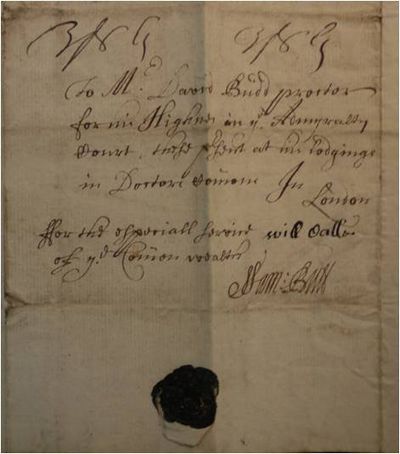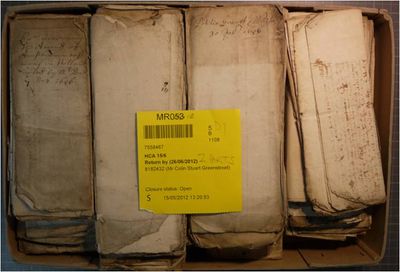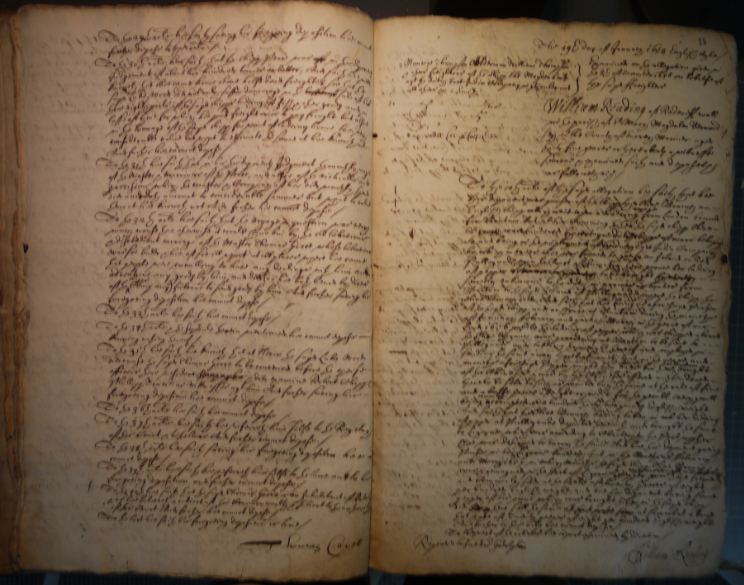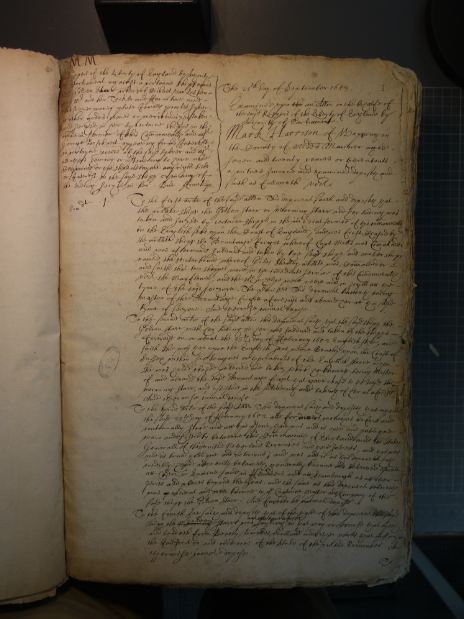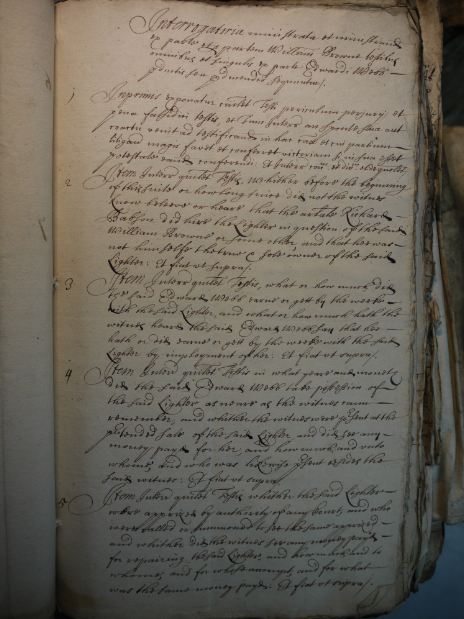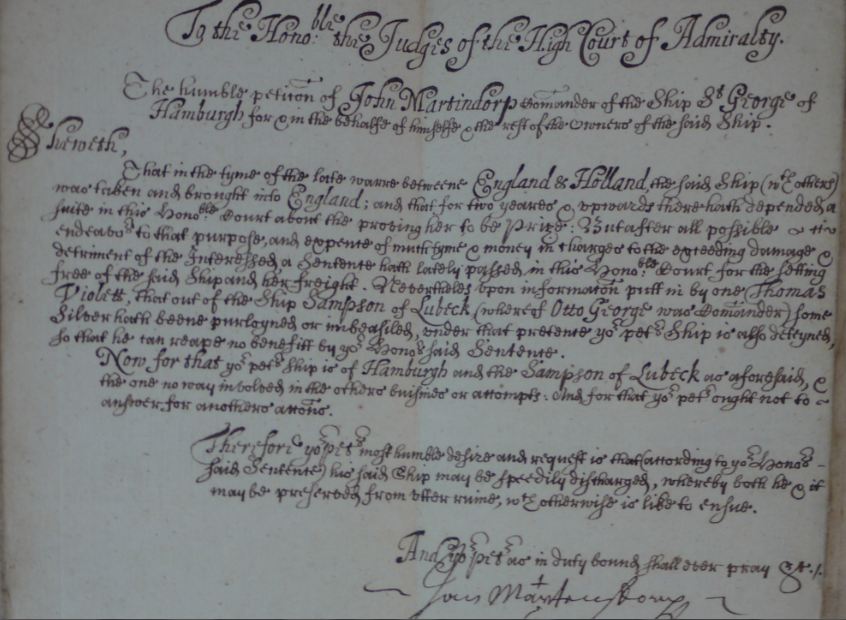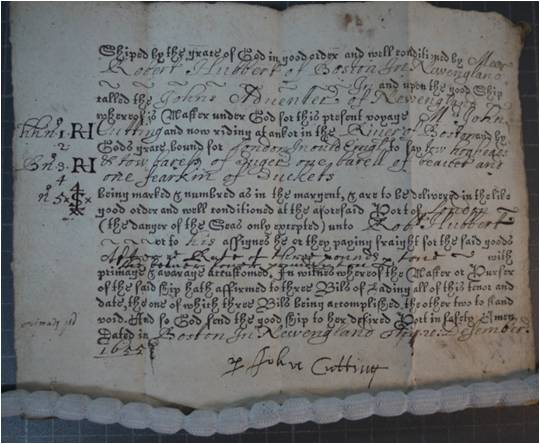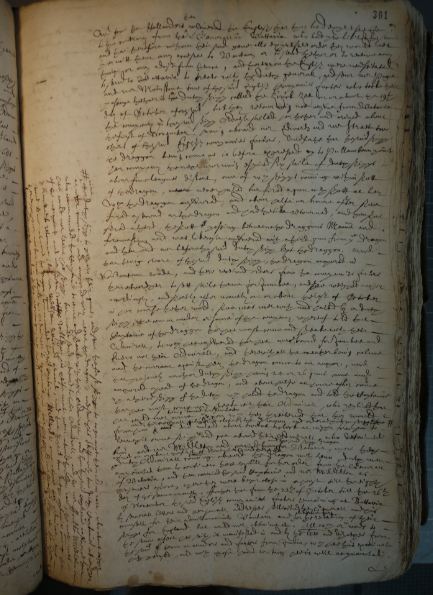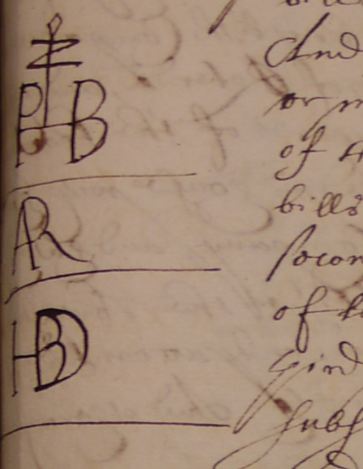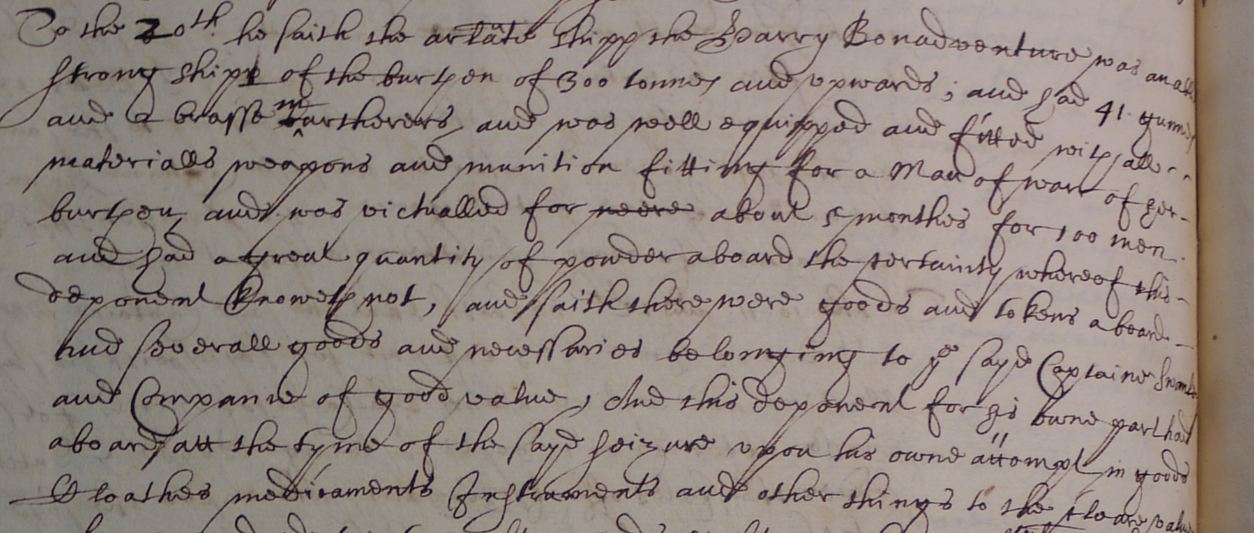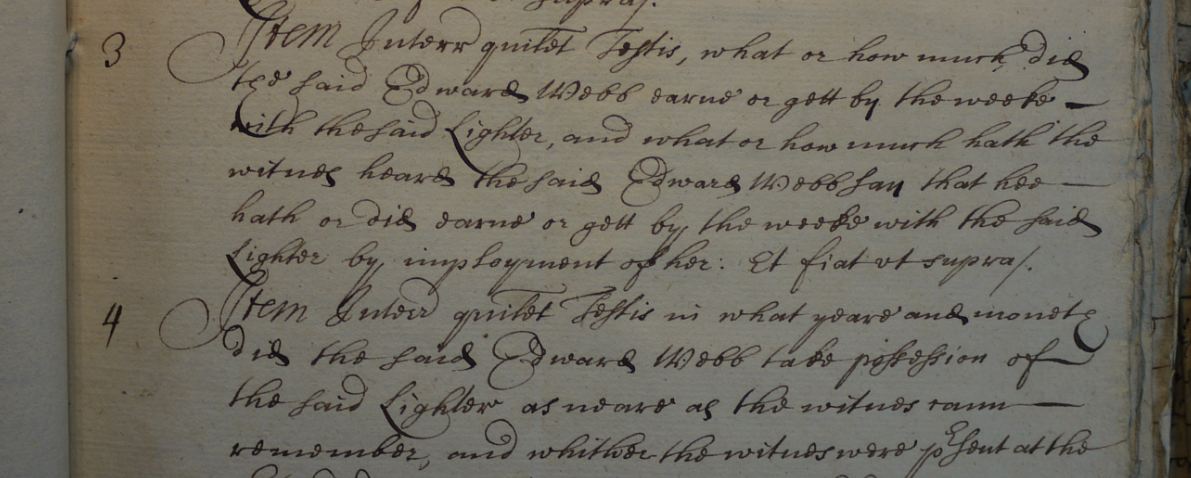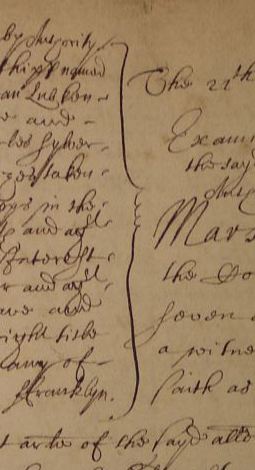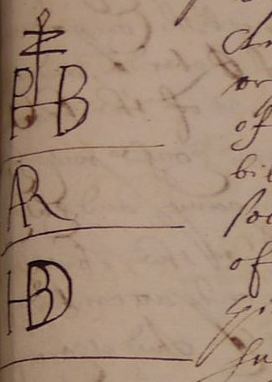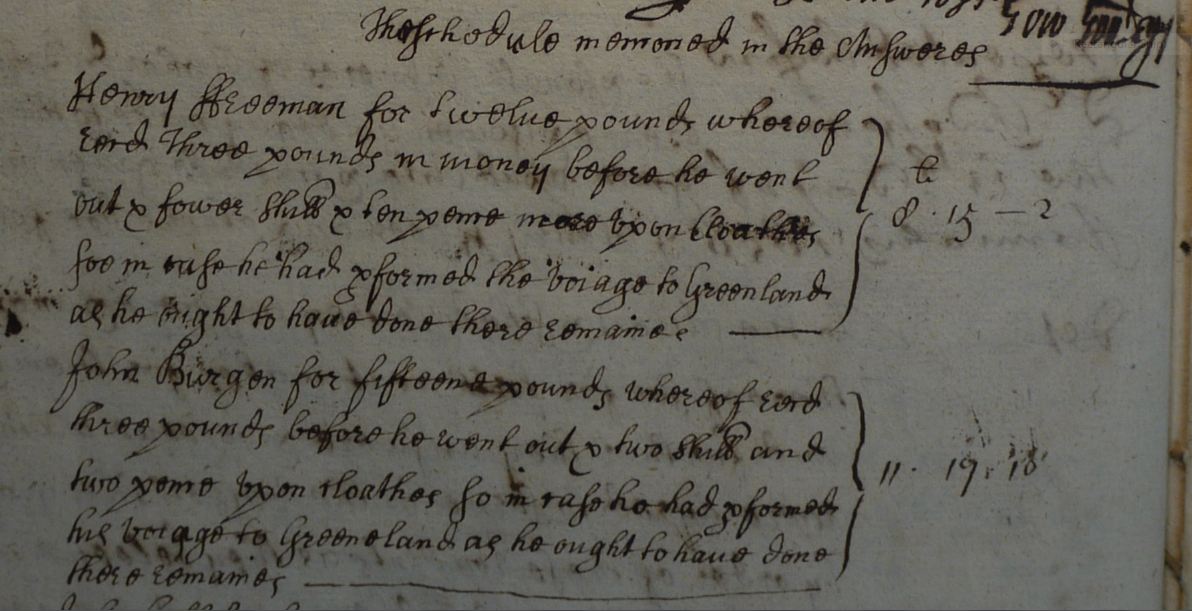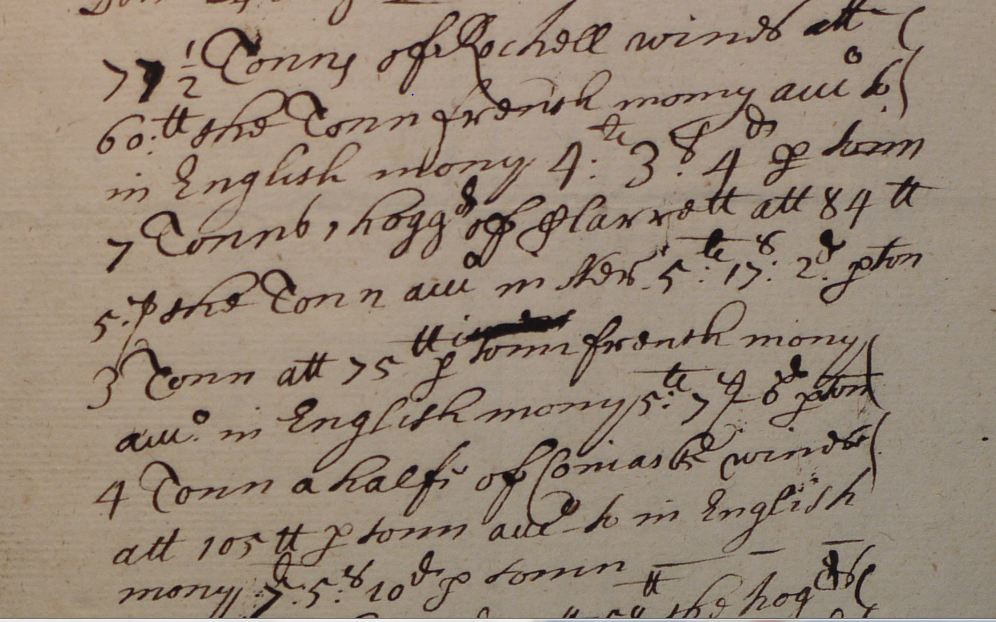Introduction to the High Court of Admiralty
Introduction to the High Court of Admiralty
Editorial history
11/08/12: CSG, created page
Purpose of this page & instructions for use
This page provides an introduction to the C17th High Court of Admiralty in London, to the structure and look and feel of the Court's documents, and to palaeographical aspects which are commonly seen in the Court's records
This page is best viewed on full screen. You can zoom in or out if you wish to view digital images in larger or smaller format. Most digital images are in thumbnail format, and when the image is double clicked, the current window will display the image in its original, larger size. By use of the right mouse button "open in new window" option, the main page can be kept open whilst allowing you to inspect the larger image in a separate window
Most digital images are followed by a link to a page containing a model transcription. These model transcription pages reproduce the digital image, provide a model transcription, and provide palaeographical tips to reading the image
Contents
[hide]- 1 What was the High Court of Admiralty?
- 2 What do the records of the Admiralty Court look like?
- 3 Types of records
- 4 Language and procedures
- 5 Tracing stories through the Admiralty Court records
- 6 What records of the Admiralty Court are at the National Archives?
- 7 Suggested reading
What was the High Court of Admiralty?
- When was the Court established?
- The High Court of Admiralty was established in the 1320 to deal primarily with questions of piracy or spoil
Illustration: Document wrapper addressed to M:r David Budd, proctor for his Highnes in y:e Admyralty Court, HCA 15/6 Box Two, ca. 1658
- What was its jurisdiction?
Jurisdiction
- Criminal – piracy, theft or violence at sea. Oyer et terminer process involving a jury. The purpose of the admiralty court was to provide swift, summary judgements for litigants and witnesses who were involved in shipping or trade, and so might not be in the country regularly or for a long time. Jurisdiction over any crimes or disputes occurring 'super altum mare' (upon the high seas). Over time its jurisdiction developed to cover prize and civil jurisdiction in such matters as salvage and collision
- Civil (or ‘instance’) – breach of contract occurring super altum mare, such as freight or charter-party, crew’s wages, possession of ship or cargo, collisions between ships, bottomry bonds. Disputed by the common law courts throughout the seventeenth century, resulting in restriction of admiralty cognisance. Actions could be taken against ships and goods as well as against persons, and suits could be started collectively (so, for instance, a whole crew could start one action together, whereas in common law they would have to start separate suits: this divided the costs and made the court cheaper)
- After the restoration (of the monarchy) in 1660, the civil business of the court divided, with an instance court and a prize court
- Prize – initially treated as ‘civil’ but increasingly a separate part of the court’s activities.
- Throughout the seventeenth century, common and civil law disputed for jurisdiction over many maritime issues, and eventually, in the later seventeenth century, the jurisdiction of the admiralty court was greatly restricted
- The Court
Personnel
Judge – usually one judge with a number of surrogates or deputies appointed by him, sometimes a number of judges. Presided, individually or collectively, over court proceedings, and decreed judgement ‘finaliter interloquendo’. Usually had served as proctor before becoming a judge.
Proctor – trained lawyer who conducted court business on behalf of litigants, e.g. entered warrants, submitted documents, presented witnesses, and pleaded their client’s cause. Might serve in a number of courts; Francis Clerke worked as a proctor in admiralty and ecclesiastical courts.
Notary Public – scribe who recorded the proceedings of the court.
Plaintiff (also party agent) – person(s) who began the cause and submitted accusations against the defendant(s). In civil law cases could be as a group and against a group, whereas in common law cases could only be one-on-one.
Defendant (also party principal) – accused person(s) or owner(s) of accused (or ‘attached’) ship or goods. In civil law cases could be in rem or in personam.
Witness (also deponent) – person(s) summoned by either party to give evidence in response to court documents. Examined before a notary public, under oath, then the deposition was repeated to the judge(s).
- Who were the judges?
- The judges were doctors of civil law, who had studied at either Oxford or Cambridge
- Specific judges in the Admiralty Court include:
-- "y:e Right Worll Leolini Jenkins d:r of lawes Judge of y:e High Court of Admiralty" (HCA 13/76 Part One f.5r))[1]
- Their legal training differed from that of lawyers practising the common law, who were admitted to Inns of Court in Holborn
- The judges of the High Court of Admiralty held court sessions at Doctors Commons, which before the London fire of 1666 was located in the parish of St Paul Bennetts wharf
Extract from Map of Baynard Castle Ward in Strype, 1720, showing Doctors Commons where the High Court of Admiralty met
Text extract: Obligation compelling George Walters to appear at Doctors Commons before the Judges of the High Court of Admiralty, March 2nd, 1656
"The Condition of This Obligacon is such That If the
Above bounden George Walters shall be and Appeare before
The Lord Protector of The Commonwealth of England x:r
the Judges of the high Court of Admyralty of England
At the Commons hall wthin y:e Doctors Commons Scituate in
The parish of Sainct Benedict neare Pauls Wharfe London
The Tenth day After the date hereof if it be Court day
or Else The next Court followinge At The usuall houres
for hearinge of Causes, To Answer unto Thomas Skinner
in A Cause Civill & Marine, And shall not departe from
-thence, without Leave, And Licence of the Court That
Then this obligacon to be void & of non Effect
Otherwayes to stand in full force power & vertue"[2]
- Several other types of legal official and lawyer attended the sessions of the High Court of Admiralty. These included proctors, public notaries, clerks, and legal counsel for the parties concerned
- The Case
Warrant -> Appoint Proctors -> Produce securities -> Plantiffs submit Libel (also called summary petition or allegation) ----->
Defendant gives a Personal answer -> Defendant submits "allegation" -> Both sides submit "Interrogatories" (questions to be asked of opposing witnesses) ----->
Both sides summon witnesses -> witnesses are examined on libel/ allegation/ interrogatories and submit "Depositions" -> Depositions are published -->
Proctors argue out cause in "Informations" -> Judge gives "Decree" and awards costs -> Case can be appealed to High Court of Delegates.
What do the records of the Admiralty Court look like?
Leather bindings
- Most of the HCA record series consist of paper manuscript pages, which have been collated into volumes and been stitched into large leather bindings. Pages are usually, but not always, in chronological order. Presumably errors in chronology occured during the collation process. Most of the bindings from the period 1650-1669 are original.
Illustration: Front leather cover of bound volume, HCA 13/68, 1653/54
- The record series HCA_15/6_Box_One is an exception, and consists of loose, boxed documents. A greater variety of handwriting is to be found in these documents, since many are the products of non-legal hands, and since the document types are very diverse. They include bills of lading, bonds, charter parties, financial accounts of voyages, inventories, letters, and petitions.
Illustration: HCA 15/6, second of two boxes of loose documents
Double page spreads
Illustration: Open volume showing left and right hand pages, HCA 13/73 f. 14v & f. 15r
[HCA 13/73 f.14v & f.15r double page Model transcription]
- Typical volumes have text on both sides of paper pages
- Folio numbers (if available) are to be found on the top right hand side of the right hand page. These right hand pages are described as "recto"
- Left hand pages do not bear folio numbers, and are described as "verso"
- Folio numbers may have been written by the court clerk at the time of collating the individual sheets into the bound leather volume, in which case they will be in ink. Or they may have been added at a later stage, also in ink, or in block printing. If block printed, they will have been added by an archivist. Occasionally there is a discrepancy of one or more sequential numbers between the original foliation and subsequent archival foliation. If so, you should note the two different folio numbers on your transcription, making clear which is in ink and which is block printed
- Margins typically left by clerks on the left hand side of both left and right hand pages
- The "gutter" is the area of the page at the centre, where the pages are bound together. The most far right text on left hand (verso) pages is sometimes hard to discern in large bound volumes, since it is not good archival practice to permit the unbinding of volumes to permit clearer photography
Page layout
Typical single leaf layout
First page in volume, HCA 13/68 f. 1r
- Text covers the bulk of the page, but with discernible blocks
- Margin available on left (of both recto and verso pages) for additional notes
- Verso pages are sometimes hard to read in digital images due to the curve of the page in the gutter. If, when you are transcribing a verso page, you can't read the text at the far right of the page, whether a letter, a partial word, or words, then tell your team facilitator. They will shout loudly and will get the project leader, Jo Pugh, or another willing volunteer, up to the map and large manuscript reading room at the National Archives in Kew to photograph another image, or failing that, to peer into the gutter and to email you their take on the "impossible to discern" letters, word, or words
- Case summary details top left
- Date of the court session (here it was the 22nd of September 1659, but written as
The 22:th day of September 1659
- Modern block printed folio number in top right hand corner (here it is folio one, and should be described when transcribing as f. 1r (folio one recto; recto = right, or front)
- Brief statement as to nature of the legal record (here it is an examination)
Examined upon an Allon on the behalfe of
the sayd Keepers of the Liberty of the Liberty of England by
Authority of Parliament
- Witness name, place of abode, and estimated age at top of main text
Mark Harrison of Wapping in
the County of Midds Mariner aged
seven and twenty yeares or thereabouts
a witnes sworne and examined deposeth and
saith as followeth. vizt
- Abbreviation in left hand margin "Ren:dt" (contraction for latin word, XXX = XXX)
- Number in left hand margin stating which number witness in the specific legal case (here this is the first witness)
- Main body of text (here consisting of thirty seven lines, divided into four paragraphs)
- Paragraphs in main body of text introduced with the phrase "To the first(second/third/fourth) arle of the sayd allon this deponent saith and deposeth that..."
- First word of next page at bottom right hand side of page, below end of main text
Numbered paragraphs
Illustration: HCA 23/19 no folio no, recto
[Model Transcription]
- First page of a series of questions to be posed in court (interrogatories)
- Page is headed with the latin word "Interrogatoria"
- The first five questions are listed on this page, and each of the questions is numbered in the left hand margin
- The first question, after the number one, starts with the latin word "Inprimis" (= In the first place)
- The subsequent four questions, from two to five, start to the right of their respective marginal numbers with the legal/latin phrase "Item Interr quilet Testis", followed by a series of related questions
Page part: Summary case details
Illustration: Clayme of Domingo Centurione, HCA 13/68 f.305v
[Model Transcription]
Page part: Fuller case details
Illustration: Parliament vs. the Golden Starr, HCA 13/68 f.1r
Page part: Page bottom
Illustration: XXXX, HCA 13/68 f.164v
[Model Transcription]
Handwriting
Very clear cursive hand
Illustration: XXXX
Very clear formal cursive hand
Illustration: XXXX
Flowing cursive hand
Illustration: XXXX
[Model Transcription]
Mixed printed text and non-legal hand
Illustration: Bill of lading, dated Dec. 20th, 1655, HCA 15/6 Box Two, no folio no.
Marginalia
Text marginalia: Block of text
Illustration: Block of text at 90 degrees in LH margin of RH page, HCA 13/73 f. 301r: XXXX
[Model Transcription]
- Short phrases are often found in the margin of depositions
- Occasionally, larger blocks of text can appear in the margin of HCA documents
- Here there is a block of text with ten lines at a ninety degree angle to the main text
Text marginalia: Abbreviation
Illustration: Text abbreviation in LH margin at start of an examination on an allegation, Xth March 1658/59, HCA 13/73 f. 52r
Merchants marks
Example: Merchants Marks in LH margin, HCA 13/68 f. 304r
To see the whole page in high definition from which the extract below is taken, [download here]
- Can you make out the letters in the Merchants marks?
- Several of them combine or overlap letters to produce stylised initials
- Merchants marks are frequently found on bills of lading, and HCA documents often refer to specific types and quantities of goods laden on ships, "as marked in the margent"
- The merchants marks are from a deposition by XXX made on XXXX. They refer to the merchants XXXX, XXXX, and XXXX.
Deletions and interpolations
Line through text
Illustration: From deposition of George Dethwick, merchant of London, aged thirty yeeres or thereabouts, dated Jan. 24th 1658/59, HCA 13/73, no folio no.
[Model Transcription]
- Can you read the words which have been crossed through?
- When transcribing this block of text, you should reproduce the crossed out words, but mark them as crossed out
[ADD EXAMPLE OF INTERPOLATIONS]
Signatures
- Signatures can be wonderfully flamboyant
- A surprising number of common seamen were sufficiently literate to sign their names
Illustration: Signatures of John Shorter, XXXX, and William Warren, HCA 13/129, no folio no., recto
- These three signatures show very different styles
- The signators are John Shorter, XXXX, and William Warren
- Note the unusual "r" at the end of Shorter, which looks rather like an "x"
- Note the shortening of William to W:m
- Note the pronounced flourish on the "J" of John, and the lengthy downward sloping lines on the "m" and "n" of William Warren
- John Shorter (b.?, d. ca. 1688) and William Warren were both London merchants and known to be in partnership in the timber trade between Norway and other countries in the "Eastlands" and London. The Eastlands was a geographical term used in the mid-C17th to refer to a number of cities, coasts and countries which broadly, but not exactly, match what we now term the Baltic area. John Shorter was later knighted and served as Lord Mayor of London. William Warren was also later knighted. Shorter and Warren were major naval contractors, dealing frequently with Samuel Pepys
- You can read a rough unedited transcription of a deposition made by Sir William Warren in 1667 regarding the Sampson, formerly known as the Johannes. The ship belonged to Hans Matson of Croskrey in Norway "in the Dominions of the King of Denmarke." The dispute concerned the seizure of the ship, which had been allegedly dispatched by Matson carrying deales (a type of timber). Warren had written to Matson in late 1666 on behalf of himself and Shorter saying that there was "great occasion for deales" since "the greatest part of London is burnt." (HCA 13/76 f.201r-f.202r: 20th May 1667)
- For a useful guide to unfamiliar mid-C17th geographical terms and language when you are transcribing HCA documents, try our online Geographical and Place Term dictionary
Illustration: The marke of Henrick Williamson, September 26th, 1653, HCA 13/68, f.4,
- The marke of Henrick Williamson appears between Henrick's first and second names
- Markes (or marks) can vary hugely. Some are the first letter of the individual's name. Others are simple drawings, or geometrical shapes. What does Henrick's marke remind you of?
- Henrick Williamson was a forty year old "common mariner", from Skadam, Holland. He was on the ship the Hart of Skadam, owned by several Skadam inhabitants, and carrying one hundred and eighty tonnes of pickled herrings. The ship had been seized by ships of the Commonwealth
- He was deposed in the case of Keepers of the Liberty of England ag:t the ship the Heart of Skadam
"The same day
Examined upon the sayd Interies
HERRICK WILLIAMSON of Skadam in Holland Mariner
aged fourty yeares or thereabouts a witnes sworne
and examined deposeth and saith as followeth.
To y:e first Interrie This deponent saith he was one of the Common Mariners
of the sayd shipp the Harts Companie, and was on board her att the tyme
of seizure by the shipps of this Commonwealth, And saith the sayd shipp
the Hart began her outward voyage from Skadam in Holland, and there
was to have ended her voyage, and so would have done had she not beene
intercepted. and saith the Master of the sayd shipp Peter ffreize and all the
shipps Companie were of Skadam aforesaid and subiects of the States of the
united provinces, which he knoweth being an Inhabitant of Skadam
and one of the sayd shipps Companie as aforesayd. And otherwise cannot depose."
(HCA 13/68, f.4r)
Punctuation
This section is a temporary section. It will be rewritten with input from Dr Charlene Eska, our palaeography advisor. She is an assistant professor of English at Virginia Tech, who specialises in linguistics and the editing of early Irish legal codes
Sample One: acute accents, dots before and after numbers
Illustration: Extract One from HCA 13/68 f.138v
- Note use of acute accents on some, but not all, lower case "a" letters at start of words
e.g. "á prisoner aboard the vice Admirall of the Dutch Shipps" (line 4)
e.g. "he cánnot depose (line7) [Transcribed using character code 00E1 from Latin-1 supplement]
- Note use of acute accent on a "c"
e.g. "come safe out of y:e Port of Trapany" (line 5)
[QUESTION: no character available in standard latin symbols for an acute on a c, so how enter this when transcribing? NOTE: bold in example has been added to highlight letter to Dr Charlene Eska]
- Note inconsistent use of dots before and after ordinal numbers (first, second, third...)
e.g. "To the • 19:th • he saith he he cánnot depose" (line7)
[QUESTION: is it correct to transcribe the dots as middle dots, rather than full stops (character code 00B7 from Latin-1 supplement, rather than character code 002E Basic Latin)?]
but, e.g. "To the 18:th he saith the sayd seizure and losse" (line 1)
- Note commas can have hooks to bottom right, rather than bottom left, and can float below a line, so could be confused with an acute accent, or some other mark, over a letter on the line
The commas don't differ significantly in length and angle with the sloping line like dot over the "i" of "Vice Admirall" (line 4) and the acute accent over "cannot deposte" (line 6)
e.g. "Last being Saturday, and upon the Monday" (line 3) The comma could be mistaken for a high acute accent above the "e" of "the Vice Admirall"
Sample Two: inconsistent use of dots before and after numbers, breves, semi-colons
Illustration: Extract Two from HCA 13/68 f.138v
- Inconsistent use of double dots around an ordinal number (see example one above for double dots)
e.g. "To the 20:th . he saith the" (line 1)
[QUESTION ONE: Should this single dot be transcribed as a full stop (character code 002E Basic Latin), since it appears to be on the line, rather than above the line. But in the double dot example above, optically the dots appear to be in the middle of the line and have been transcribed using middle dots (character code 00B7 from Latin-1 supplement)]
- Use of breves above small letter "a"
e.g. "he saith the arlăte shipp the Harry Bonadventure" (line 1)
[QUESTION ONE: Has the transcriber correctly identified the mark above the second "a" or "arlate" as a breve (ă)? Is it correct to use the character code 0103 Latin Extended-A to transcribe this letter?]
[QUESTION TWO: How should transcriber show the long horizontal line from above the "r" of "arlăte" through to above the "e" of "arlăte"? My understanding is that this is a mark used by the clerk writing the word to show he has used a contraction.]
- Semi-colons and dots
e.g. "300 tonnes and upwards; and had 41 • gunnes" (line 2)
[QUESTION: The semi-colon is well formed and legible, but should the dot between "41" and "gunnes" be transcribed as a middle dot (character code 00B7 from Latin-1 supplement) rather than a full stop (character code 002E Basic Latin). It appears to be a middle dot]
- Potential confusion of dots and acutes in italic hands
e.g. "was well equipped and fitted"
[QUESTION: The mark above the "i" of "fitted" looks like a right sloping line, although contextually the transcriber can presume it is a dot, if the convention is adopted that "i" never has an acute accent. But this contradicts the current Draft of MarineLives Editorial Method/Directions for Transcribers, dated 13th August 2012 which states "Transcribe the marks as you see them"; NOTE: bold in example has been added to highlight letter to Dr Charlene Eska]
- Double upward & rightward sloping lines in italic hand (line 10)
e.g. "his owne accompt"
[QUESTION: What are the marks above the two "c"'s? How should they be transcribed? Are they indicating use of a contraction by the clerk, or do they modify the sound of the letter. Presumably the word is the mid-C17th spelling of "account"? NOTE: Bold in example has been added to highlight letters to Dr Charlene Eska]
Sample Three: colons, end of paragraph markings
Illustration: Extract from HCA 23/19 no folio no. recto, XXX
- Note clear use of colon dividing end of English question, separating the question from the concluding latin phrase
No use of a question mark in this case, although question marks are used elsewhere in mid-C17th HCA documents
e.g. "Lighter by imployment of her: Et fiat ut supra/." (LINE 6)
- Note also in the same example above that the paragraph formed by the entire interrogratory numbered three is ended with an upward sloping right hand leaning line followed by a full stop
This combination of a sloping line and full stop was frequently used by clerks at the end of paragraphs, and is different from a horizontal line of varying lengths, at the right hand side of a page, which was frequently used by clerks to fill empty space.
- variants of the "/." include "./.", and ":/:"
[QUESTION: Should transcribers be encouraged to reproduce exactly what they see? I believe so, and this is currently the policy expressed in Draft of MarineLives Editorial Method/Directions for Transcribers, dated 13th August 2012]
- Note the use of upper case letters in contracted forms of words
e.g. "and whither the witnes were p^r^sent at the (line 10)
[QUESTION: How should use of superscript (and subscript letters, though none detected to date) be transcribed? They usually occur in contractions (as in "p^r^sent" for "present"), however, presumably "y^e^" is not a contraction, though it is unclear whether clerks did not consistently write the "e" of "y^e^" in superscript, and sometimes wrote "ye". Superscripts are not directly addressed in the current Draft of MarineLives Editorial Method/Directions for Transcribers, dated 13th August 2012, though there is a discussion in the current draft regarding use of 'thorn'. I am not in agreement with the recommendation of the current draft Editorial Method/Directions that "y" should be transcribed as "th", and would like to discuss this]
Comments & Issues
- C17th use of question marks?
- C17th approach to capitalisation within sentence structures?
- were capitals used at the start of questions? Consistently? Inconsistently?
Spacing
Large areas of empty space on a page
Illustration: HCA 23/9 no folio no. verso, XXXX
[Model Transcription]
[QUESTION: How should a transcriber address reproducing page layout? Should it be in the form of transcriber notes about the layout of the page, or should it be a direct attempt to reproduce the location of text and text blocks on a page, both vertically and horizontally? How should a transcriber address noting or reproducing areas of blank manuscript? For example, text only occupying the top one third of a page, or a solitary number or title appearing in an otherwise blank manuscript page?]
Horizontal and vertical lines
- Vertical lines and line like shapes
Illustration: Vertical tie linking text block on left of page to text block further to right, HCA 13/68 f.1r
- Is this line called a tie or a ligature in editorial terminology?
- Example: 1. Parliament vs. the Golden Starr, HCA 13/68 f.1r, showing a clear medium length vertical line "summing" horizontal lines together as a text block)
e.g. See above: Illustration: Schedule, HCA 13/128, no folio, recto, 1657 (multiple short vertical lines which "sum" lines in one column together against a single cost or price in an additional column
e.g. See above: Illustration: Clayme of Domingo Centurione, HCA 13/68 f.305v (unclear short off-vertical slanting line)
- Horizontal lines and line like shapes
- Lines used as vertical space dividers
Illustration: Merchants marks separated in margin by horizontal lines, HCA 13/68 f.304r
- Example: Merchants Marks in LH margin, HCA 13/68 f. 304r, showing the use of medium length horizontal lines as dividers between picture objects on page)
- Lines used as horizontal space fillers
e.g. See above: Illustration: Schedule, HCA 13/128, no folio, recto, 1657 (wiggly horizontal lines as space fillers)
Money & specie
Schedule mentioned in the answers, HCA 13/128 no fol. no., verso
- This case concerns common seamen sueing the master of their former ship for payment of their wages
- The schedule from which the above excerpt is taken is annexed to the bottom of answers made by witnesses
- The remaining wages allegedly due are listed net of cash payments made to the seamen before the voyage commenced and payments in kind for clothes
e.g. Henry Freeman's agreed wages for the voyage were twelve pounds sterling. Three pounds were paid out in advance in money, and a further four shillings and ten pence of value was received in clothes. The net amount due in wages is therefore eight pounds fifteen shillings and two pence, which is the amount listed in the right hand column as 8^li^ • 15 - 2
- Note that the abbreviation "li" above the 8 stands for "libra", or "pound"
- English currency: Pounds, shillings, pence
- Common non-English currencies: dollars; gilders; livres; peeces of eight; ryalls;
- Specie: barrs; gold; sylver;
See: Currency and Specie
See: Abbreviations
Weights and measures
Extract from second schedule, August 24th, 1655, HCA 13/128 no fol. no., recto
- This extract is from a second schedule annexed to answers made in a case in the Admiralty Court in 1655. It lists the cost price of a set of goods laden on a ship, the value of the goods being contested in the court
- Inconsistent use of singular and plural terms for weights (e.g. "tonn" and "tonns" in lines 1 & 6)
- Unusal letter form for "s" in "7 Tonns" (line 4)
- Inconsistent orthography (e.g. "p tonn" (end line 3) and "pton" (end line 5)
- Use of abbreviations for measures (e.g. "hogg^d^" for hoggshead (hogshead))
- Use of colons to divide numerals in statements of pounds, shillings and pence, but inconsistent, and sometimes use single stop in same monetary statement
- e.g. "4:^li^ 3.^s^ 4^d^ p tonn" (line 3)
- e.g. "5:^li^ 17:^s^ 2.^d^" (line 5)
- Can you make out line 4? Is that a comma or a "1" after "7 Tonns"? What does the hogshead contain, and at what price? (note that the price runs over into line 5)
- Lines 4 and 5 read:
"7 Tonns 1 hogg^d^ of Clarett att 84li
5.p the Tonn all in Ster. 5:^li^ 17:^s^ 2.^d^ pton"
Note the ambiguity as to whether "li" and "s" are positioned before or after the colons
- Can you make out the last two words in line 8?
- they read "Conicack wines"
- Note the two different letter forms for "c" used by the clerk, one for "claret" and another for "coniack"
See: Weights and Measures
See: Abbreviations
- Common, but less familiar, weights and measures: hogshead; kintall/quintall; last; parcel(l); pipe; quarter; roll; yard
Fractions
[DEVELOP THIS SECTION]
Numbers
Cardinal
[DEVELOP THIS SECTION]
- 1, 2, 3
- One, two, three
Ordinal
[DEVELOP THIS SECTION]
- (first, second, third, fourth...)
- mid-C17th usage is to use "th" even when we would use "st" and "nd" when expressing ordinal number in arabic numerals rather than words
- so first, second, third, fourth, fifth...twenty second
- but 1^th^, 2^th^, 3^th^, 4^th^, 5^th^,...22^th^,
Types of records
- Why were records kept?
- Who kept the records?
Allegations
- What is an allegation?
- An example: XXXX
Answers
- What is an answer?
- An example: XXXX
Examinations
- What is an examination?
- An example: XXXX
Interrogatories
- What is an interrogatory?
- An Interrogatory is a pre-prepared list of questions to be put to deponents by the proctors of the High Court of Admiralty
- An interrogatory consists of numbered questions which are primarily English, though often introduced with Latin phrases
- Such interrogatories can be found in bound leather volumes in the HCA 23 record series, for example HCA 23/19 (1658-1664)
Illustration: Loose foldover front leather cover with clasp, HCA 23/19 (1658-1664)
- Example from HCA 23/19
- Example: Introduction & first question from Interrogatories in behalf of John Absolun[3]
Interrogatoryes on the behalfe of John Absolon
to be administered to whatever prdsed wutnesses
produced or to bee produced on the behalfe of
Nicholas Payne as followeth,
1 Imprimis Interrogot:r quilet testis to what shippe hee belonged
and how hee commeth to be a witnes in this cause whether
hee doth not well know that the Shipp the Swanne of
which the said Absolon was master commeing from New-
castle upon or about the seaventeenth of may last 1660
about 10 or 11 of the clock in the morneing sett saile
from or neare Newcastle with her ladeing of coales
and whether the shippe the Prospous (sic) of Bright Hampton
did not follow next after the Swanne and y:t they turned
about the bill poynt, Whether the Prospous had not
the greater wynd & did becalme the Swanne & whether
the Maste or some other of the Company of the Swanne
did not call out to the company of the Prosperous to
loare (sic) theire top sailes or else they would come
foule of them, & whether some of y:e Prosperous did not
heare & make answeare that they would warrant that
they would bee foule of them or to that effect, or what
did they say, And let each bee asked joyntly sewally
and of each particular,
Illustration: Text on recto, no text on verso, fastened by tie in top LH corner, HCA 23/19, unfoliated (1658-1664)
Further single question examples from HCA 23/19
"4. Itmm: interr. When had the Claymers or the wittnesse first
Notice that the shippe Nativity was stayed neere ffalmouth..."[4]
"1 Imprimis Interrogot:r quilet testis to what shippe hee belonged
and how hee commeth to be a witnes in this cause..."[5]
Schedules
- What is a schedule?
- Schedules of information are occasionally referred to in individual answers or in individual examinations
- These schedules are only rarely included in the volume which contains the answers or examinations, despite reference to the documents being "annexed"
- Occasionally, schedules can be found in boxes of loose documents (usually unfoliated), such as HCA 15/6 Box One 1654-1657, and HCA 15/6 Box Two 1654-1657
Illustration: Schedule, HCA 13/128, no folio, recto, 1657
[Model Transcription]
- This schedule is from HCA 13/128, a volume which covers 1658 to 1662
- The HCA 13/128 series is one of a number of volumes for the 1650-1669 period which are described as answers to bills of complaint (HCA 13/123 - HCA 13/130)
- The schedule lists XXXXX
Schedules can also be in languages other than English
one of y:e ffrigatts Company y:e ffrancis the aclate Captaine W:m
?Brustowe Commander went on board and seized or stopped the shipp
S:t Ignatius aclate in Yarmouth Roade within the Isle of Wight, And saith
that under a little parcell of tobacco in a private place of y:e great Cabbin of y:e S:t
Ignatius this deponent found the three schedules or ffrench lres
aclate N:o 6. 7. 8 and breaking them open found them to bee ffrench
but could not understand them, and some two dayes after such his
finding of y:e said lres this depo:t gave them to y:e said Captaine
W:m Burstow Commander of y:e said ffrancis ffrigatt, And saith this
deponent is well assured that y:e said three lres annexed are the
same which he found in the Ignatius as aforesd
(HCA 13/76 Part Two f.203r))
Language and procedures
- English, with a little latin
- What latin will you find, and how can you read it?
Common Latin Phrases
- English legal and commercial language
Legal & Commercial Terms
Tracing stories through the Admiralty Court records
- As you and your team start to transcribe consecutive pages, narratives will emerge, of individuals and of families; of ships' companies and of ships themselves
- These narratives may emerge within a single page, or over a series of pages within one answer or examination.
- But a good number will emerge only after a large number of sequential answers or examinations have been transcribed, often with chronological gaps and interspersed with answers or examinations on completely different cases. In many cases this was probably due to the lack of availability of all witnesses on a particular day or consecutive days, due to seamen and mariners being overseas
- One example of a larger narrative to emerge from transcriptions done at the preparatory stage of the MarineLives project is that of Daniel Skinner the elder and his sons. Daniel Skinner the elder was a Dover merchant, as were two of his sons. A further son, Albertus Skinner, was a London merchant.
- If you would like to read more about Daniel Skinner, take a look at the Daniel Skinner case study. This case study synthesises a complex narrative from multiple depositions. Indeed there are probably more relevant depositions in the volume, but time has precluded surveying the entire volume. In the case study you can look at the unedited transcriptions of these depositions. The volume in question is HCA 13/69, and is for the year 1654
- This case study provides a good example of what can be done to link and enrich a transcription.
- The relevant Admiralty Court claim is the "clayme of Daniel Skinner the Elder, Daniel Skinner the younger & Thomas Skinner"
- Two depositions have been taken as the starting point to link and enrich the transcription - the deposition of John Ashurst the younger, of St Andrew Undershaft, merchant, and the deposition of Albertus Skinner, S:t George Buttolphe Lane, merchant.
- Online and offline primary and secondary sources have been used to dig deep into the identities of the individuals and places mentioned, and to look at family and commercial connections
- Manuscript sources have included wills, and Chancery Court records
- Online printed sources have included calendars of Treasury books, of State Papers, of the East India Company, and of the House of Lords and House of Commons journals. They have also included online books of printed primary sources, such as parish registers, and online printed editions of C17th letters, such as the correspondence of Samuel Pepys
- These sources have been accessed physically at the National Archives, Kew, and online via the National Archives Discovery tool, British History Online, Internet Archive, and Google Book
- But all this is icing on the cake. Our starting point on the Marine Lives project is to become familiar with the High Court of Admiralty records and to produce a top quality, accurate, consistent transcription of the words on the page. This will be our focus in training at our kickoff session on August 20th 2012, and for our week of facilitator supported training in the week of September 3rd 2012. It will also be our focus for at least the first eight weeks of the project, as we proceed through September and October and become more comfortable with our transcription skills, and each facilitator supported team begins to develop a corpus of transcribed material
What records of the Admiralty Court are at the National Archives?
- What records are in Kew?
- The National Archives at Kew contains the extensive records of the High Court of Admiralty from as early as 1536 until 1859
- How did they get there?
- How can you see them?
- The records of the High Court of Admiralty can be viewed in the Large Manuscripts and Maps Room on the second floor of the National Archives at Kew
- You will need a reader's ticket, which can be obtained on the day of your visit. You will need to take two valid pieces of identification with you - one with a recent photograph of you, and the other with your home address and of a recent date. See Obtaining a Reader's ticket
- HCA manuscripts can be ordered at any terminal in the Large Manuscripts and Maps Room, and may take between thirty and sixty minutes to be produced from storage
- The National Archives are closed on Sundays and Mondays, but are open Tuesday through Saturday, with late opening on Tuesday and Thursday. See TNA Opening Times
Suggested reading
Appleby, John C. (ed.), A Calendar of material relating to Ireland from the High Court of Admiralty Examinations, 1536-1641 (Irish Manuscripts Commission, 1992)
Murphy, Elaine (ed.), A calendar of material relating to Ireland from the High Court of Admiralty, 1641-1660 (Irish Manuscripts Commission, Dublin, 2011)
Senior, W., Doctors Commons and the old court of admiralty (London, 1922)
- Internet Archive online edition
Shilton, Dorothy O. and Richard Holworthy, High Court of Admiralty Examinations, 1637-1638 (London, 1932)
Snell, Steven L., Courts of admiralty and the common law: origins of the American experiment in concurrent jurisdiction (Carolina Academic Press, 2007)
Steckley, George F., 'Collisions, Prohibitions, and the Admiralty Court in Seventeenth-Century London,' Law and History Review, Spring 2003, viewed 10 Nov. 2011
Steckley, George F., 'Instance cases at admiralty in 1657: A court "packed up with sutors"', The Journal of Legal History, vol. 7, issue 1, 1986, pp. 68-83- Jump up ↑ HCA 13/76 Part One f.5r, Case: The Orange tree and XXXX: Deposition: Andreas Barton, midshipman, & John Ennet, John Carter, John Rice marriners, of the Crowne ffrigott Date: August 23rd, 1666
- Jump up ↑ HCA 15/6: Item: Bond George Walters, of the Middle Temple, London Esq:r and Thomas Walker of Camberwell, Surrey: Date: March 2nd 1656 (57) no f.
- Jump up ↑ HCA 23/19: Document Number: 6: Case: XXXX: Date: XXXX: P1100666 no f., verso
- Jump up ↑ HCA 23/19: Document Number: 4: Case: XXXX: Date: XXXX
- Jump up ↑ HCA 23/19: Document Number: 6: Case: XXXX: Date: XXXX
